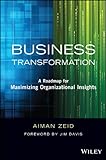Business transformation : a roadmap for maximizing organizational insights / Aiman Zeid. [electronic resource]
Material type: TextSeries: Wiley and SAS business seriesPublisher: Hoboken, New Jersey : Wiley, [2014]Copyright date: ©2014Description: 1 online resource (206 pages) : illustrationsISBN:
TextSeries: Wiley and SAS business seriesPublisher: Hoboken, New Jersey : Wiley, [2014]Copyright date: ©2014Description: 1 online resource (206 pages) : illustrationsISBN: - 9781118891483 (e-book)
- 658.4/038 2 3
- HD30.2 .Z444 2014
| Item type | Current library | Call number | Status | Date due | Barcode | |
|---|---|---|---|---|---|---|
| Ebook | TUS: Midlands, Main Library Athlone Online | eBook (Browse shelf(Opens below)) | Available |
Includes bibliographical references and index.
Machine generated contents note: Foreword Preface Acknowledgments Chapter 1 The Critical Role of Business Insight The Disruptive Nature of Data An Unconventional Look at Conventional "Wisdom" Innovating at the Speed of Data Weighing Risk and Bringing the Better Part of "Gut Instinct" Back into the Equation People, Process, Technology, and Culture Starting the Journey Notes Chapter 2 The Journey: Taking the First Steps toward Transforming Your Organization Different Approaches Juggling Multiple Challenges How to Deal with Challenges Effectively Executive Sponsorship: Critical to Success Understanding Current Capabilities Aligning Capabilities with Business Objectives Let's Start the Journey Taking the First Steps to Transforming Your Organization Note Chapter 3 Challenged Organizations: When Rugged Individualism and Department Silos Aren't Enough Getting Along One Day at a Time: Organizations at the Individual Level When "Have It Your Way" Isn't a Good Thing Superhighways and Dirt Roads Consolidated, but Not Cohesive: Organizations at the Departmental Level Subject Matter Experts and Gatekeepers Understanding the True Consequences of the Challenged Levels Business Transformation Strategy Objectives for Challenged Organizations Notes Chapter 4 Foundational Organizations: Making the Leap to an Enterprise-Wide Approach The Possibilities That Come with Patience Seeing the Value across the Enterprise How an Enterprise Level Organization Functions Big Data: The Big Opportunity for Enterprise Level Organizations Don't Let Up Continuous Improvement Required Business Transformation Strategy Objectives for Foundational Organizations Chapter 5 Progressive Organizations: Harnessing the Power of Information to Achieve Market Advantage and Expand Their Business Offerings Optimization: The Easiest Business Case of All Toward Innovation and Beyond Business Transformation Strategy Objectives for Progressive Organizations Chapter 6 Centers of Excellence: The Key to Accelerate Organizational Transformation The 10,000-Foot View of Information A Quick Look at the Key Responsibilities of a CoE CoEs and the Levels of Maturity How Should CoEs Be Organized? Accelerating Maturity--Not Creating Dependency Finding the Right Spot in the Org Chart Mapping the Mini-Units That a CoE Might Host How the CoE Helps Secure the Organizational Pillars People Information Processes Technical Infrastructure Culture Phased versus Big Bang Approach for Starting a CoE Finding the Right Funding Mechanism Selecting the Right Personalities Ramping up Your Change Agent Note Chapter 7 Starting the Journey: Developing a Strategy and Roadmap to Guide Your Business Transformation Knowing Where to Start Riyad Bank's Enterprise Business Intelligence Competency Center E.SUN Bank's Customer Risk Value Organization Success Story Takeaways Applying the Lessons from E.Sun and Riyad The Most Important Characteristics of Successful Business Transformation Strategies A Step-by-Step Look at the Key Components Identifying a Starting Point Summing It All Up In the End, It's about Being a Leader Appendix Snapshot of the Information Evolution Model The Individual Level: Getting along one day at a time Departmental Level: The consolidated organization The Enterprise Organization: A Common Sense of Purpose The Optimize Level Organization: Aligned and Ready The Innovate Level: Spawning and supporting new ideas Glossary About the Author Index.
"Effectively introduce and promote analytics within your enterprise. All companies use information to set strategies and accomplish business objectives. But how many CEOs and CIOs would say they are satisfied that their companies get maximum value from information? The Data Advantage reveals how SAS's Information Evolution Model (IEM) can be used together with analytics for groundbreaking results. Author Aiman Zeid provides the necessary information you need to introduce and promote the use of analytics and insight across your organization. Along with examples and best practices of global companies that have successfully been through this process, you'll learn how to identify the starting point and develop a road map for execution. Reveals how to introduce and promote the use of analytics and insights across your organization Written by a lead developer at SAS global Business Intelligence Competency Center program and services Features global case studies and examples Practical and insightful, this reference provides businesses with an essential blueprint for creating improvements that optimize business returns and put the potential of data analytics to work"-- Provided by publisher.
Description based on print version record.
Electronic reproduction. Ann Arbor, MI : ProQuest, 2015. Available via World Wide Web. Access may be limited to ProQuest affiliated libraries.
